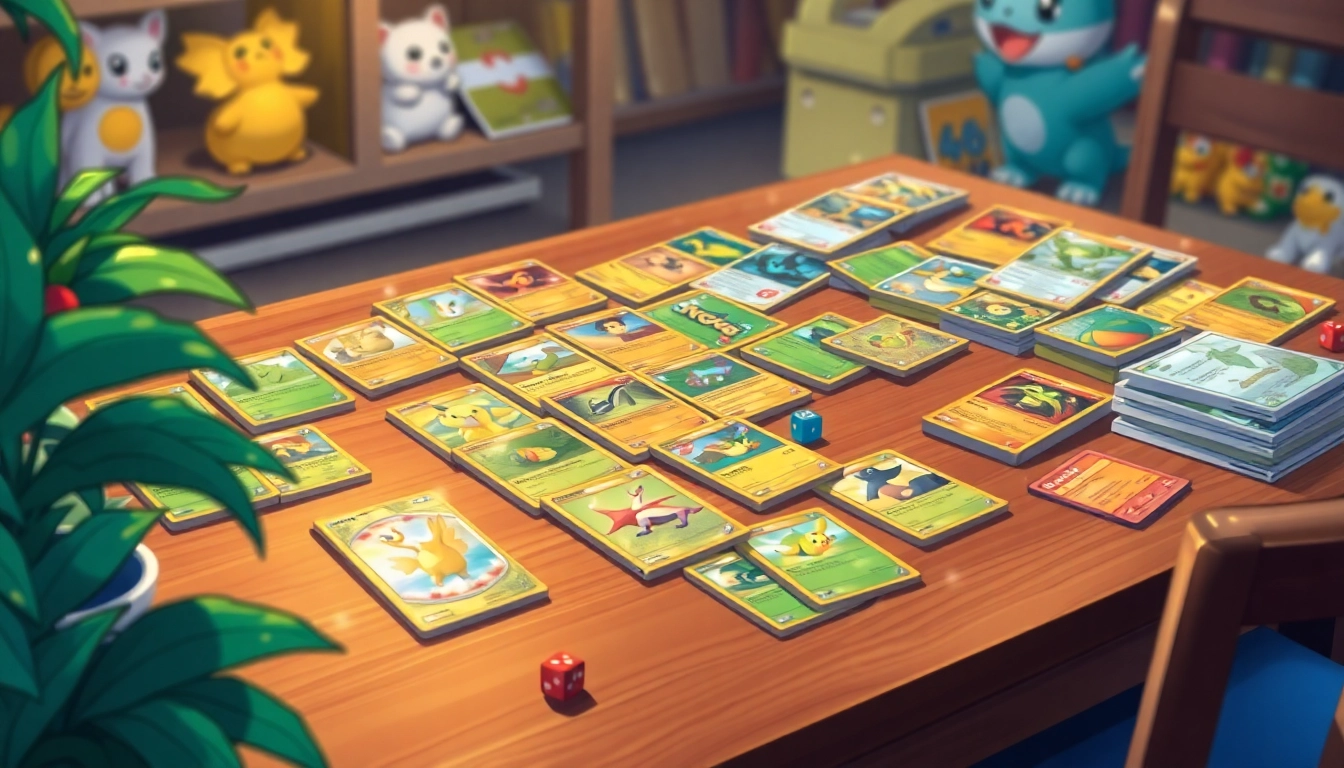Understanding Real Pokemon Cards
The world of Pokémon cards has captivated collectors, kids, and adults alike since their debut in the late 90s. The stunning artwork, exciting gameplay, and nostalgia for many childhood experiences have led to a thriving market for both players and enthusiasts. In this comprehensive guide, we’ll explore real pokemon cards, providing insights into what makes these cards authentic, where to buy them, how to identify counterfeits, and best practices for caring for your collection.
What Are Real Pokémon Cards?
Real Pokémon cards are officially produced cards that have been manufactured by The Pokémon Company. These cards are used in the Pokémon Trading Card Game (TCG), where players create decks and engage in battles. They can also serve as collectibles, with certain cards holding significant value due to rarity, condition, and demand.
Each card typically features Pokémon characters, types, abilities, and different art styles. The first set of Pokémon cards, known as the Base Set, was released in 1996 in Japan. Since then, numerous expansions and series have been introduced, leading to a vast library of collectable cards.
Key Features of Authentic Pokémon Cards
Identifying genuine Pokémon cards involves understanding several key characteristics:
- Card Material: Authentic cards are made from a specific type of cardstock that provides durability and a unique tactile feel. They are neither too thin nor excessively thick.
- Accuracy of Artwork: Real cards have clear, high-quality prints. Any blurriness or color inconsistencies may indicate a counterfeit.
- Holofoil Characteristics: Cards with holographic foil display unique shine and patterns. Authentic holos tend to reflect light in a specific way that is hard to replicate with fake cards.
- Set Symbols: Each card has a small symbol indicating its set. This symbol can help determine the card’s authenticity as well as its value.
- Text Clarity: The text on real Pokémon cards is perfectly aligned and centered, with no spelling mistakes. A genuine card’s text is sharp and clear.
Why Collect Real Pokémon Cards?
There are many reasons collectors might gravitate towards real Pokémon cards:
- Nostalgia: Many collectors grew up with Pokémon and these cards bring back fond childhood memories.
- Investment Potential: Certain cards can appreciate significantly in value over time, especially rare or graded versions.
- Community Engagement: Collecting offers a way to connect with other fans and enthusiasts, whether through online platforms or local events.
- Gameplay Enhancement: For players, collecting real cards ensures they have the legal chance to use a vast arsenal of abilities and tactics in matches.
Where to Buy Real Pokémon Cards
Finding authentic Pokémon cards might seem straightforward, but it’s essential to know where to seek them out to avoid untrustworthy vendors.
Top Online Retailers for Pokémon Cards
There are many reputable online stores where players and collectors can buy real Pokémon cards:
- Pokémon Center: The official Pokémon retailer offers a wide variety of products, including the newest and most sought-after TCG expansions. Visit their eCommerce platform for the latest releases.
- Cardmarket: Europe’s largest online marketplace for Pokémon cards, allowing users to buy and sell singles, booster packs, and collections.
- Amazon: While selection may vary, established sellers on Amazon often have authentic Pokémon cards available for purchase, including booster packs and single cards.
Local Game Stores and Their Offerings
Local game stores often have dedicated sections for trading card games, including Pokémon. Engaging with these stores can provide the following benefits:
- In-Person Assessments: Being able to see and feel cards before purchasing ensures authenticity.
- Community Events: Many stores host tournaments or trading nights where players can meet and share their love for the game.
- Expert Advice: Store owners and employees are typically knowledgeable and can provide insights on which cards to buy or trade.
Tips for Finding Good Deals on Pokémon Cards
Finding the best deals requires a mix of patience, research, and strategy:
- Compare Prices: Always cross-reference prices across multiple platforms to ensure you’re getting a fair deal.
- Join Collector Groups: Many collectors share deals or sales on forums like Reddit or Facebook groups.
- Watch for Sales: Keep an eye out for holiday sales or special promotions, especially from major retailers.
- Second-Hand Markets: Websites like eBay can yield deals, provided you thoroughly verify the seller’s reviews and card conditions.
Identifying Real vs. Fake Pokémon Cards
With the popularity of Pokémon cards comes an increased risk of counterfeiting. Knowing how to identify real cards is essential for any collector.
Common Signs of Authenticity
To ensure a card is real, you can look for the following indicators:
- Weight: Real Pokémon cards have a certain weight. If a card feels unusually light, it may be fake.
- Card Texture: Authentic cards should have a specific texture. They are smooth but may have some slight texture, unlike paper copies.
- Black Light Test: Under a black light, real Pokémon cards will have a specific glow, while fakes may not glow or even appear differently lit.
How to Spot Counterfeit Cards
When assessing cards, it’s crucial to be vigilant about potential signs of counterfeit production:
- Poor Print Quality: Many counterfeit cards have sub-par printing, characterized by blurry images or inconsistent colors.
- Wrong Holo Patterns: The surface finish on holographic cards from counterfeits tends to lack the unique patterns seen in real cards.
- Inconsistent Fonts: Pay attention to discrepancies in font type or size, as counterfeits often fail to match the authentic cards.
Tools and Resources for Verification
Consider using various tools and online resources to authenticate Pokémon cards:
- Grading Services: Companies like PSA or Beckett can grade your cards, providing an official verdict regarding their authenticity and condition.
- Online Guides: Numerous websites offer detailed breakdowns on identifying real versus fake cards, with images to guide your assessment.
- Community Input: Engaging in forums or discussion groups can provide collective insights on suspected fake cards.
Caring for Your Pokémon Card Collection
Once you’ve established your collection, protecting your investment is crucial through proper care and maintenance.
Best Practices for Card Storage
Storing cards correctly helps preserve their condition:
- Use Sleeves: Employ high-quality plastic sleeves to protect cards from dirt, moisture, and physical wear.
- Toploaders: For valuable cards, consider using toploaders, which provide additional support and protection against bending.
- Store Flat: Cards should always be stored flat and not bent or crumpled, as this can reduce their value significantly.
Essential Accessories for Collectors
Having the right accessories makes a big difference in collection management:
- Binders: For card organization, binders with specific pages for Pokemon cards help keep collections visible while protecting them.
- Storage Boxes: These boxes can effectively house multiple cards while keeping them dust-free.
- Display Cases: For particularly rare cards or displays, consider utilizing display cases that can showcase your collection beautifully.
How to Protect Your Investment
Beyond physical storage, other protective measures for your investment may include:
- Insurance: Depending on the value of your collection, you might want to consider insurance covering its worth.
- Keep Cards Away from Sunlight: Prolonged exposure to light can fade card colors, so store them in dark or low-light environments.
- Regular Maintenance Checks: Regularly assess cards for signs of wear or damage, and take necessary actions promptly.
Joining the Pokémon Card Community
Collecting Pokémon cards is not just a solitary activity; numerous communities exist where enthusiasts can connect, share, and learn.
Online Forums and Communities to Explore
Online forums provide robust platforms for discussion, trading, and learning:
- Reddit: Subreddits such as r/PokemonTCG offer insights, discussion threads, and trading opportunities with fellow collectors.
- Facebook Groups: Many themed groups on Facebook cater specifically to Pokémon card collectors, making it easy to engage with others.
- Discord Servers: There are active Discord communities where users can chat and discuss everything related to Pokémon cards in real time.
Participating in Local Events
Engaging with local communities is as rewarding as online interactions:
- Tournaments: Many stores host tournaments allowing players to test their decks while meeting fellow enthusiasts.
- Trade Days: Events specifically designed for trading cards can lead to mutually beneficial swaps and deals.
- Meetups: Informal meetups can be arranged through community boards to foster physical connection among collectors.
Connecting with Fellow Collectors
Building relationships with other Pokémon card enthusiasts can lead to valuable exchanges of information and cards:
- Networking: Utilize events and online platforms to expand your network of like-minded collectors.
- Sharing Insights: Regularly engage with your peers typically yields valuable insights on trends, sales, and market changes.
- Collaborative Trading: Make deals with trusted acquaintances to strengthen bonds and enhance collections.



